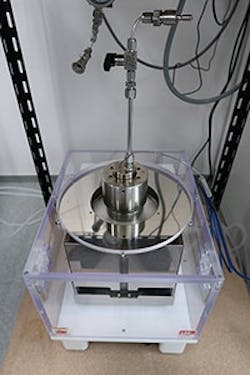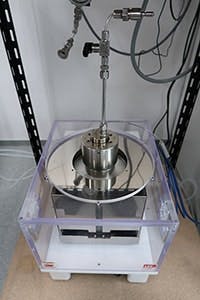Waste Polyolefins Become Feedstocks
Figure 1. Reaction takes place at a lower temperature than needed by other plastics conversion processes. Source: Osaka City University.
A novel catalyst enables producing liquid fuels and waxes from recycled polyolefinic plastics at yields of up to 92% of useful materials, say its developers at Osaka City University (OCU), Osaka, Japan. Moreover, the heterogenous catalyst, a combination of ruthenium and cerium dioxide (Ru/CeO2), works at 473°K rather than the 573–1,173°K required by other waste-plastic-recycling processes.Masazumi Tamura, associate professor in the Research Center for Artificial Photosynthesis in the Advanced Research Institute for Natural Science and Technology at OCU, and Keiichi Tomishige, professor in the Graduate School of Engineering in Tohoku University, Sendai, Japan, already had found that Ru-based catalysts showed high activity and selectivity in the hydrogenolysis of single short (≤30 carbons) alkanes.
They wondered if the same catalyst would work with polyolefinic plastics.
The longer chains, different molecular weights and structures, high viscosity and poor hydrogen diffusion in such plastics hamper contact between themselves and catalysts, thus reducing reactivity.
The researchers carried out the hydrogenolysis reaction in a 190-mL stainless steel autoclave pressurized to 6 MPa with hydrogen (Figure 1). They ran trials with various polyolefins, including low-density polyethylene, high-density polyethylene and polypropylene. Yields of valuable chemicals ranged from 83–92%.
A commercial polyethylene (PE) food bag was converted to 87% C5–C21 liquid fuels and 4.3% C22–C45 waxes. Waste PEs gave the same conversion to liquid fuels but 1.6% waxes.
Describing the work in a recent issue of Applied Catalysis B: Environmental, the OCU team reported that the Ru/CeO2 catalyst selectively dissociated the inner C–C bonds in polyolefins without isomerization or aromatization, which enabled the high yield of the target valuable chemicals.
Catalyst stability poses the biggest problem for reaction scale-up, states Tamura. “Waste plastics have many impurities, which can poison the catalyst.”
Other potential issues he highlights are catalyst durability and cost.
“Catalysts composed of cheap metals would be ideal for the system. Therefore, developing a new catalyst system substituting for Ru-based catalysts is desirable. As for the process, a fixed-bed reactor would be ideal for the industrial process. However, feeding the waste plastics and regeneration of the catalyst will be problems.”
The team already is working to improve its existing process and also is seeking the funds and extra resources needed to carry out in-depth process simulation investigations.
“Many companies, including chemical and petroleum companies, show interest in the catalyst system, although I cannot go into details. Currently, however, the study is not supported by enough national and corporate funding,” notes Tamura.

